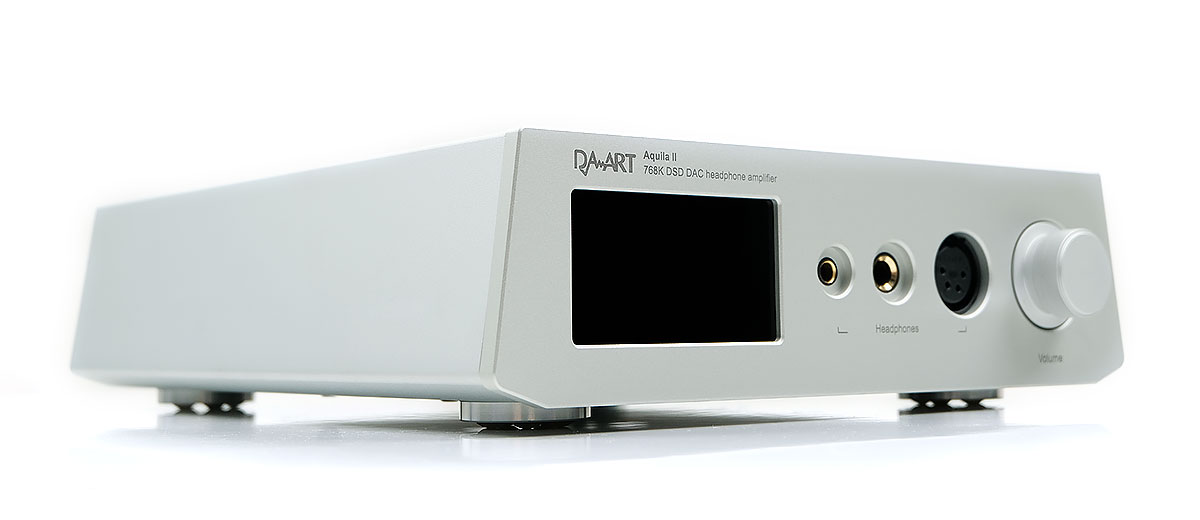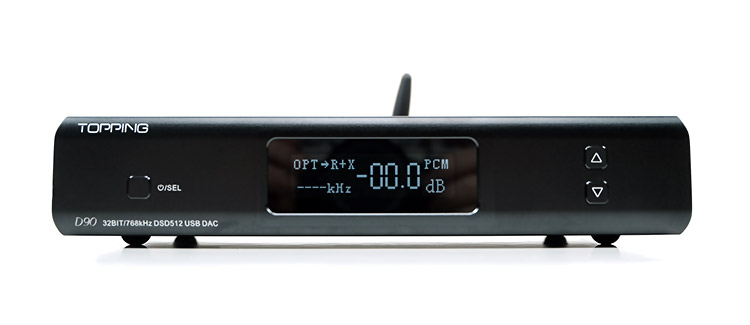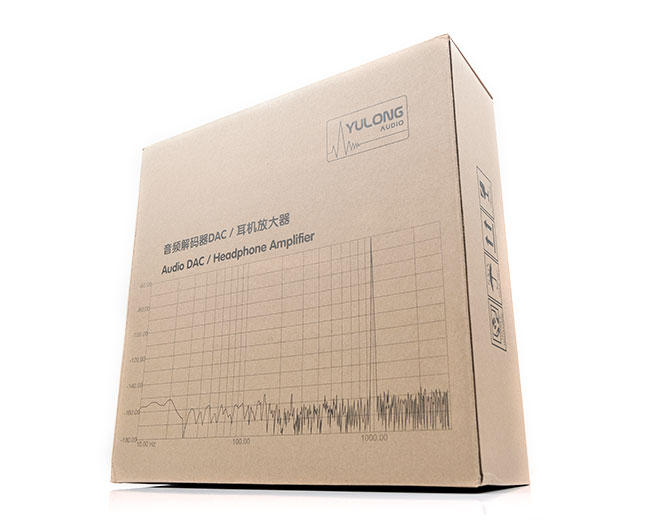Aquila II Headphone Amplifier
Efficiency
For medium efficiency and low SPL IEMs, the Aquila II headphone amplifier performs very well indeed. However, for sensitive IEMs such as the Campfire Audio Solaris (SE) and Noble Audio’s Sultan, you will hear a fair amount of background hiss using the 4.4mm balanced output. It would be better to switch to the quieter single-ended 6.35mm unbalanced output with adapters.
More current demanding electrostatic models such as the Empire Ear’s Odin with its 108dB SPL rating had a tiny bit of background hiss but were far less pervasive than the Solaris and the Sultan. This is a pairing I could easily use with the Aquila II.
Once you drop the SPL to something like 64 Audio’s tia Trio’s 104dB and AAW Canary’s 100dB rating do get a beautifully black background and above-average channel balancing at low volume levels. The Canary in particular sounded exquisite with immaculate instrumental separation and superior dynamic range than some higher-end and more expensive DAPs.
I have to give props also to oBravo’s TOTL Ra C-Cu which needs a lot more voltage at 180Ω and can be a tricky customer for both synergy and correct power levels. Not only did it deliver a beautifully black background and excellent dynamic range going 4.4mm balanced with the Aquila II but the sync mode took some of that treble aggressiveness out of the general presentation. A very listenable and detailed pairing.
Dynamic Driver Headphones
For dynamic driver headphones such as Ultrasone’s Edition 11 and AKG’s K872, you will not find any issues driving either from the 6.35mm single-ended output.
The Edition 11 sat very comfortably at -40dB and around 75% on the Chromebook’s internal volume control via USB-C. Both headphones were impeccable for low noise and good black backgrounds with the Aquila II and more than enough headroom to sound well driven given their respective 32Ω loads.
For efficient planar headphones such as the Final D8000 Pro or Audeze’s LCD-1 the single-ended 1.5W output capability of the Aquila II is pretty good. However, for dynamic headphones such as the HD800 at 300Ω, the balanced output of the Aquila II felt the more worthy option with a better level of dynamic range from the more powerful output.
AMT Headphones
For the Hedd Audio Heddphones, you do need balanced. This is a 42Ω 87dB SPL AMT driver and it needs lots of current which the single-ended output of the Aquila II seems not to be able to supply.
The dynamic range also is a bit lacking for me unbalanced. Going balanced with the Heddphone changes things for the better offering a punchier more powerful low-end and a more vivid midrange sound. Keeping the mode to ASRC also seems preferable to retain that vivid midrange and expand the perceived staging height and treble energy of the Heddphones performance.
Planar Headphones
Abyss Headphones Diana V2
Firstly, this is a challenging set of planar headphones to drive so you do need to go balanced with the Aquila II, be it XLR or 4.4mm. Using the MAS capable USB input from a mobile source the Diana V2 will suck up plenty of current to around -25/20dB but there are no issues with dynamic range and they do sound well driven.
I was more mode agnostic with the Diana V2 when paired with the Aquila II. Why agnostic? I found myself using both depending on what I was listening to.
For vocal smoothness and additional weight in the timbre, the sync mode was excellent. However, at times I really wanted something more expansive and vivid sounding and the ASRC mode does a better job filling out the staging width much like the Heddphones pairing.
That is not to say the Diana V2’s low-end is lean using ASRC mode. A good example is the final few seconds of Mark Ronson’s Daffodils collaboration with Kevin Parker and its super ‘phat’ synth ending for just how fleshy the Diana V2 low-end with the Aquila II pairing can sound, in either mode.
Meze Empyrean
The Meze Empyrean was dead easy to drive from the Aquila II in using both balanced and unbalanced outputs. The dynamic range was excellent as was the degree of instrumental separation and the black background this pairing offered.
As to the 2 modes, While the sync mode can give you a little bit of lower-mids girth and a smoother delivery on the Empyrean, I actually felt that was not playing to the Empyrean’s strengths.
The Empyrean is a naturally smooth sounding headphone but more on the relaxed side for treble. The ASRC mode teased out a presentation that sounded a little more balanced and vivid sounding for mids and vocal performances.
The sync mode tends to smooth out the edges a little also for staging width. It is still wide but with a slight softness that the ASRC corrects on the Empyrean. This, in turn, helps you quickly pick out nuanced spatial cues and deliver a perception of stronger width and height.
Select Comparisons
YULONG DA10
$1200
Technical
The DA10 came a little earlier than the Aquila II and is positioned a little higher also at a $500 markup. There are a few reasons behind that despite it using YULONG’s Aquila I box-shaped or older design and the AK4497 DAC inside which I rate a step lower on paper than the Aquila II’s ES9380 Pro chipset.
Both digital implementations can natively decode up to DSD 512 and PCM768kHz and use proprietary FPGA with a FIFO buffer, a low noise Femtosecond clock generator, and a PLL circuit before it hits the DAC. Both deploy the same 3 digital filter options albeit with slightly different responses given the different DACs used inside each unit.
However, the DA10 does not have the Aquila II’s Dual ESS Digital Processing Circuit or the MAS features so no synchronous or ASRC modes or mobile source handling via USB.
The key differentiator is really the resistor-based Class A amplifier topology and superior power supply deployed on the DA10 which is a step up on the Class A/B opamp block solution inside the Aquila II.
On paper specs for noise were pretty much equal between the two at 125dB dynamic range and an SNR rating of 130dB. Also, on paper, the Aquila II has a more powerful output in terms of raw numbers. It can churn out up to 4W balanced compared to the DA10 which is a little weaker at 3W at 32Ω.
However, in an unbalanced format, the DA10 has a bit more grunt at 2W into 32Ω compared to the Aquila II’s 1.6W into the same load. That advantage is consistent up to 600Ω with the DA10 capable of 110mW compared to 90mW from the Aquila II.
Design
Aside from the different design lines, the only key physical difference between these two-component systems is the additional 4.4mm balanced output on the Aquila II. The rear panel I/O, dual-function potentiometer, LCD screen, and regular XLR/635mm PO on the front panel are the same. They even weigh the same at 4kg each.
Performance
At 4W vs 3W balanced, a higher rated DAC chipset, and two types of sound signature, I was really wondering if the Class AB setup of the Aquila II could outdo the Class A DA10 in terms of dynamic range or resolution.
Not quite, the gap is close, but there are some definite differences when it was paired with an HD800 and an HD600. Some of that will come down to pure timbral and staging preference but there is a slight resolution or detail gap also which is a knock-on effect in part from the timbral differences.
Tone
The overall tone of the DA10 is as if the Aquila II had a ‘sync uber’ mode. By this, I mean warmth and body, particularly on the low-end. Throughout the DA10 shows off its AKM/Class A credentials with a fuller-sounding low-end, a richer instrumental timbre, and a more liquid top-end including vocals.
Within that richer timbre or better sustain of the DA10, you can hear more detail shine through for instrumental and vocal texture. The Aquila II offers a more forward mid and treble and at times a punchier low-end but the note body is a little lighter and slightly less expressive in terms of textural detail.
Granted, the sync mode on the Aquila II is warmer than the ASRC mode but it still sounds a little drier and more neutral-sounding than the DA10. The ASRC mode itself is the brightest of the 3 sound signatures with less bass weight, more mids, and treble presence, and the lightest in terms of instrumental and vocal body.
Dynamic Range
You could argue that the DA10 topology has a more typical Class A sweeter sound combined with a DAC chipset that I regard as having a bias to a more musical and liquid delivery. That does shine through with the DA10 when compared to the more neutral Aquila II.
The dynamic range on both is excellent but with the DA10 you do get a slightly enhanced sense of control. Whereas the Aquila II sounds the more energetic and the busier of the two but slightly reduced in terms of control and separation.
Topping D90
$699
The D90 is a DAC and preamp and is very similarly priced to the Aquila II. You could argue that makes the Aquila II the better value proposition as it also offers a headphone amplification stage.
However, DAC functionality and performance can be very important to many at this price point so it is worth noting what the difference might be when running both out to an analog amp. In this case, we used the $800 Monoprice Liquid Platinum which both single-ended and balanced for inputs and outputs.
Technical
The D90 uses a flagship AKM AK4499 DAC implementation which is pretty much the same level, (some would argue higher) as the Aquila II’s ES9038 Pro DAC chipset.
Both digital designs have Femtosecond dual chipset implementation and both components use an XMOS XU208 USB stage meaning top-tier decoding rates of DSD512 and up to PCM 32BIT/768kHz.
The D90 has a slight edge on paper with regards to the dynamic range at 127dB compared to 125dB on the Aquila II. However, the Aquila II on paper seems to have the lower noise floor by 3dB. I am presuming both have the same 1kHz weighting when these measurements were produced.
Features
The two components also feature optical, coaxial, and AES/EBU digital inputs with the D90 also featuring I²S connectivity which the Aquila II does not have. Both have balanced 3-pin XLR and unbalanced RCA analog outputs and be set to variable preamp volume control or fixed-line voltage output.
The Aquila II does control volume in the analog domain whereas the D90 is all digital volume control.
The other major difference is the wireless support on the D90 with a Bluetooth 5.0, LDAC capable module inside. The Aquila II has no streaming support but it can accept a mobile source input via USB with MAS digital processing control for jitter.
In terms of design, the D90 is much smaller and lighter unsurprisingly as it has no amplification stage. The display on the D90 is a bit basic compared to the more legible LCD panel on the Aquila II but it does have a remote control which I would love to have seen included with the Aquila II.
Performance
The D90 sits somewhere in between the sync and ASRC mode of the Aquila II DAC performance. As such I find it a fairly linear and neutral DAC with excellent dynamic range.
Compared to the Aquila II ASRC mode, the D90 has a bit more density and presence on the low-end, a slightly wetter attack, and a bit more separation on the mids and treble though with slightly less energy.
The Aquila II does sound the more energized of the two DACs in the upper mids and treble in ASRC mode. It can sound more extended but perhaps not as clear or as well separated as the D90’s top-end performance.
Sync mode is warmer, fuller sounding, especially though the lower-mids and like the D90 has some nice control on the top-end. I suspect both have a very slight fade on the treble with the sync mode on the Aquila II a little more relaxed on the upper mids also.
It does have a little less vocal focus through the mids compared to the D90’s stronger midrange presence but at the same time, the sync mode attack is more liquid and pulls some more warmth from the mid-bass to lower-mids so it sounds more forgiving in the mids.
On the low-end, the Sync mode of the Aquila II has a bit more bloom and body whereas the D90 has a tighter mid-bass punch and sounds the pacier the two DAC sound signatures.
Our Verdict
The value proposition of the Aquila II at $700 is excellent, in all honesty. You get a modern DAC implementation, two qualitatively different sound signatures, a heck of a powerful headphone amp, and the ability to preamp or pure DAC out to an analog amplifier of your choice.
That is great value in anyone’s books and a refreshing example of more ‘honest’ pricing in this often-overheated audiophile market.
Drawbacks? Gosh, the lazy modern consumer in me does wish a remote control was included, and the lack of I²S connectivity or gain control might be seen as a lost opportunity for some. I also think the DA10 still has an edge in terms of pure amplification and a ‘juicer’ sound signature despite the lower output power numbers.
However, if your budget is tighter then Aquila II ticks plenty of worthy and relevant boxes. Headphones are not an issue in terms of power, portable transports sync perfectly well and medium to low-efficiency IEMs sound excellent.
If space is a premium or you simply want to cut down on the clutter, cables, and power sockets then the YULONG DA-ART Aquila II is definitely worth considering.
YULONG DA-ART Aquila II Specifications
- ESS9038Pro DAC Chip, with dual decoding mode
- Full FPGA digital signal low jitter processing module, YULONG JIC(Jitter and Interfacing Control)
- PCM decoding up to 32-Bit/768kHz, DSD up to DSD512 natively
- Frequency Response Range: 20Hz-30kHz
- THD+N: 0.00025%
- Dynamic Range: 125dB
- Signal to Noise Ratio: -130dB
- Cross Talk: < -120dB
- Multiple Input Ports: USB, AES, Optical, SPDIF
- Multiple Output Ports, 4-Pin XLR balanced port, 4.4mm, and 6.35mm
- Unbalanced output power: 1600 mW @ 32 Ω; 870 mW @ 64 Ohms; 370 mW @ 150 Ω; 180 mW @ 300 Ω; 90 mW @ 600 Ω
- Balanced output power: 4000 mW @ 32 Ω; 3000 mW @ 64 Ohm; 1500 mW @ 150 Ω; 750 mW @ 300 Ω; 375 mW @ 600 Ω
- Output Impedance: ~2Ohms
- Output Voltage(RCA): 2.1V
- Output Voltage(XLR): 4.2V
- Analog Volume Control
- Supports Windows, iOS, Mac, Android, Linux.
- Aluminium Alloy Metal Shell
- Power Consumption: <30W
- Dimensions: 248x210x60mm(LxDxH)
- Weight:4Kg








